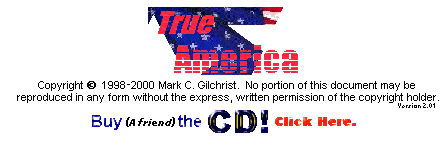Lacing up for the Big Game
Announcer: Good afternooon and welcome to Super Ball XXXIII. This is Carl Topgrain and we are in pregame, here in Ada, Ohio. The players are in the locker rooms, getting ready, while the fans are filling the stadium.
Color Announcer: That's right, Carl. It always surprises me how they do it. Only 5,500 people live in this small town and most are with the Ohio Northern University, so it must be quite a shock each year as over one-hundred thousand people converge to watch, participate in and cover this incredible event.
Announcer: The Ada Motel is booked solid.
Color Announcer: Hey, just try getting a sandwich down at the 302 Carry Out. ONU students are renting out their dorm rooms to reporters...
Announcer: Here at War Memorial Park, where the Ada High School Bulldogs play, the stadium is filling up fast and there is such excitement in the air! I always get a chill at this point, Jim. I mean, we are about to watch Super Ball XXXIII, where the very footballs for Super Bowl XXXIII will be made! Someone get me a towel!
Color Announcer: You're not kidding, Carl. Every year, millions of people around the world watch the Super Bowl, and everything they watch involves this little, odd-shaped ball, and that ball is made right here at the Wilson Sporting Goods factory!
Announcer: It took them a few days to move their equipment from the factory out on the field for us, but boy, is it worth it.
Color Announcer: Carl, you know, it takes 27 steps to make a football? And you thought they just glued them together. Can we get a good shot from the blimp, guys?
Announcer: Jim, this is radio, they can't see... We have Pam Clark in the women's locker room, interviewing one of the Lacers, Linda Hattery. Pam?
Color Announcer: If I could interrupt, Carl. We have got two great players, here. Pam Clark has been an inspector on the Wilson team for two decades and her record is stunning. Hattery has been lacing Wilson footballs for thirteen years - her average is an impressive 180 balls per day!
Announcer: Don't interrupt me, Jim.
Color Announcer: It's my job.
Announcer: I don't care. Just...
Pam Clark: Hello? Guys?
Announcer: Pam Clark, are you there?
Pam Clark: And waiting... I'm here with Linda Hattery, who is preparing for the big event. As you know, we imprint the names of the two teams playing the Super Bowl on the balls they use in the game. We only have two weeks before Super Bowl Sunday to do this, so it's a scramble.
Color Announcer: Yes, it is. You make 24 balls for each team to practice with before the game and 72 balls for the actual Super Bowl.
Pam Clark: Right, Jim. It is very important that those 72 balls get to the game, so we send them in two separate shipments. Right now, Linda is preparing for the event by taping her fingers - why do you do this, Linda?
Linda Hattery: We have to pull the laces very tight, over a thousand times a day, and that lace can really cut. We used to lose skin on these before we taped them.
Pam Clark: I see you have very heavy tape on your index and forefingers. Why is that?
Linda Hattery: I make finger cones, because we pull with these two fingers the most. That lace will cut your fingers real deep.
Pam Clark: You said it! This cord you're using is made of cotton, coated with vinyl.
Linda Hattery: Yes, there are two cords on the NFL balls, actually. The "gridcord" is 28 inches long and is laced through the holes. The "Latigo" cord is 29 inches long and goes straight across.
Color Announcer: I wanted to tell them that.
Linda Hattery: Don't interrupt, Jim.
Pam Clark: Linda, you must be proud to watch the NFL teams compete on national television with something you helped make.
Linda Hattery: Yes, and I think how hard we worked to make each ball and then they just throw it around. (she laughs)
Pam Clark: Makes you just want to run out on the field, doesn't it? But Linda, there are several Lacers, so you don't always know they're playing with a ball you laced, do you?
Linda Hattery: If they show the ball up close, I'll say; 'that's my ball, it's a perfect lace.' (more laughter)
Announcer: We are about to start the event, ladies and gentlemen. The stadium is packed, pay-per-view is hitting record levels and I hear that tickets are going for hundreds of dollars outside the gate.
Color Announcer: You ain't kidding, I paid $400 for mine.
Announcer: Lose your press pass again, Jim?
Color Announcer: Yeah. Did you know that Wilson has been the official NFL supplier since 1941?
Announcer: Very impressive. Now, as Pam mentioned, these people have only two weeks to make balls for the Super Bowl. Usually, they will make those balls about sixty percent of the way, beforehand. Then, as soon as they know who will be in the game, they stamp the teams' names on the balls and finish them. Today though, we will watch as the balls are made from start to finish.
The players are taking the field. There are about 200 employees at the Wilson Plant, and we have a fraction of them on the field today. There's the huddle, and they take their positions.
Pam Clark: Jim, the referee is inspecting the materials to be used, carefully checking the cowhide. This leather comes from ranches in America's midwest states. They imprint the special texture on the hide using several tons of pressure...
Color Announcer: Eighteen balls per cow.
Pam Clark: I'm sorry?
Color Announcer: Um. They can make fifteen to eighteen footballs out of one cow's hide - I read that somewhere...
Pam Clark: Thanks, Jim. The referee is inspecting the laces, the lining material and now the bladder - these are made of a vinyl and urethane material and are what actually holds the air in the ball. He approves of the pieces and we are about ready.
Color Announcer: Down at the Ada factory, they make seven thousand footballs each day, and nothing is automated - it's all done by hand. You know, that's 1.2 million...
Pam Clark: We are ready! The referee has punched the time clock and we're off!
Announcer: Mary Howard, a Cutter,
Color Announcer: Mary is in her 48th season with Wilson - Incredible!
Announcer: Yes, and she hands the panels to the Stamper,
Color Announcer: This team is very strong on imprints. They print NFL, college and even high school names on footballs. You can custom order anyth...
Announcer: The Splitter is now making sure that each panel weighs exactly the same - Oh-oh - it looks like one is a little heavy and she is shaving off a thin layer and... yes! A perfect split! Pam, did you see that beautiful move?
Color Announcer: As you know, each ball must weigh between 14 and 15 ounces. If one panel weighs more than another, it'll fly funny.
Announcer: Oie Lawrence
Pam Clark: Thanks, Carl. Jean Sexton
Kay Baughman
Color Announcer: Carl, that is a tricky play, sewing that leather so straight. Can we get an instant replay?
Announcer: Jim, this is RADIO! Thank you, Pam. What an exciting event we are witnessing today! The crowd is cheering - they can't believe the display of skill and teamwork on this field today. This is just incredible!
Mark Conky
Color Announcer: Conky turns four to five hundred balls each day - what a workout!
Announcer: He puts the ball in a steam oven first, to make it pliable, and - he is now hammering the ball, giving the ends a good point. And, what's this? Looks like Pam has called a Time-out!
Pam Clark: Yes, Jim. I've noticed a thread that is frayed on this ball. We've sent it back to have it re-sewn and... it is back in play!
Color Announcer: Pam is in charge of Quality Control for Wilson. I tell you, she never takes her eye off the ball...
Announcer: The Bladder is now being inserted into the ball, and... there it goes, into the pre-mold to give it shape and to check for uniformity. Pam, I believe we're ready to lace!
Pam Clark: Linda Hattery
Color Announcer: Did you know that Linda Hattery listens to country music while she works? Most of the players wear headpho...
Announcer: Thank you, Jim. We're on the final play right now, and the crowd is cheering!
Pam Clark: Yes, Carl. The final inspector is taking a careful look at the ball and... Yes! She tosses it into the cart! We have a ball! The crowd is on their feet! The Wilson team is taking hi-fives and jumping with excitement. Spectators are coming down to get autographs - they are storming the field!
Announcer: What an exciting time here, in Ada, Ohio. And it is exciting every year, as this small town has, for the past thirty-two years, been the only place in the world where we get to witness the real Super Bowl kick-off.
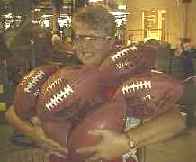
Pam Clark holds some of the 7,000 footballs made each day
Check out the
True America Made in the U.S.A. Archives
Return to our
MAIN page
|


 has the ball - at least part of it - first. It only takes her a few seconds to press four panels out of a piece of hide.
has the ball - at least part of it - first. It only takes her a few seconds to press four panels out of a piece of hide.
 who stamps the NFL logo and the teams' logos onto the leather. The Die-out cuts holes for the laces...
who stamps the NFL logo and the teams' logos onto the leather. The Die-out cuts holes for the laces...
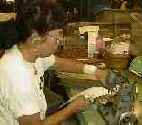 is on the play now. With masterful technique, she sews a thin liner material to each panel. Pam is on the field for the up-close.
is on the play now. With masterful technique, she sews a thin liner material to each panel. Pam is on the field for the up-close.
 has sewn the four panels into two half sections, facing inside out, and the Roll Pounder quickly inverts the fold.
has sewn the four panels into two half sections, facing inside out, and the Roll Pounder quickly inverts the fold.
 sews the two halves together and hands the ball to another Lock Stitch Sewer who sews the fourth and final edge, leaving a gap, which the laces will close. We now have a football shell - inside-out! Back to you Jim.
sews the two halves together and hands the ball to another Lock Stitch Sewer who sews the fourth and final edge, leaving a gap, which the laces will close. We now have a football shell - inside-out! Back to you Jim.
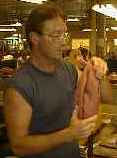 is the Turner with the ball now. He turns the ball outside-out and wrests with it to get all the edges smooth.
is the Turner with the ball now. He turns the ball outside-out and wrests with it to get all the edges smooth.
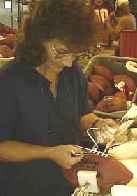 prefers to use a clamp, but many lacers still hold the ball the old-fashioned way - between their legs. Hattery has the Latigo in and is lacing the Gridcord now...
prefers to use a clamp, but many lacers still hold the ball the old-fashioned way - between their legs. Hattery has the Latigo in and is lacing the Gridcord now...
 The ball is put in a steel shell and pumped up with 180 pounds of air to give it that perfect shape. Then the pressure is brought down to the regulation amount of thirteen pounds and... We are NEAR THE GOALPOSTS ladies and gentlemen!
The ball is put in a steel shell and pumped up with 180 pounds of air to give it that perfect shape. Then the pressure is brought down to the regulation amount of thirteen pounds and... We are NEAR THE GOALPOSTS ladies and gentlemen!
